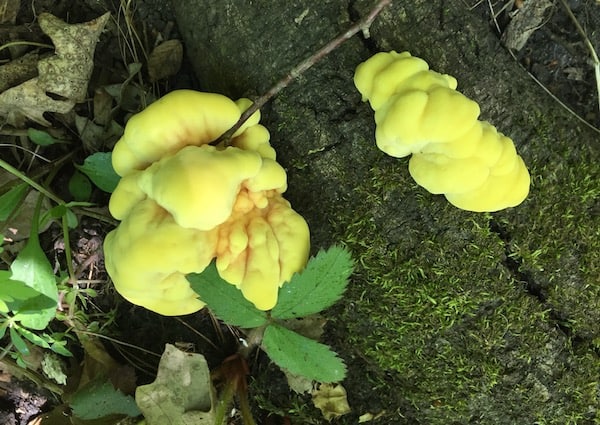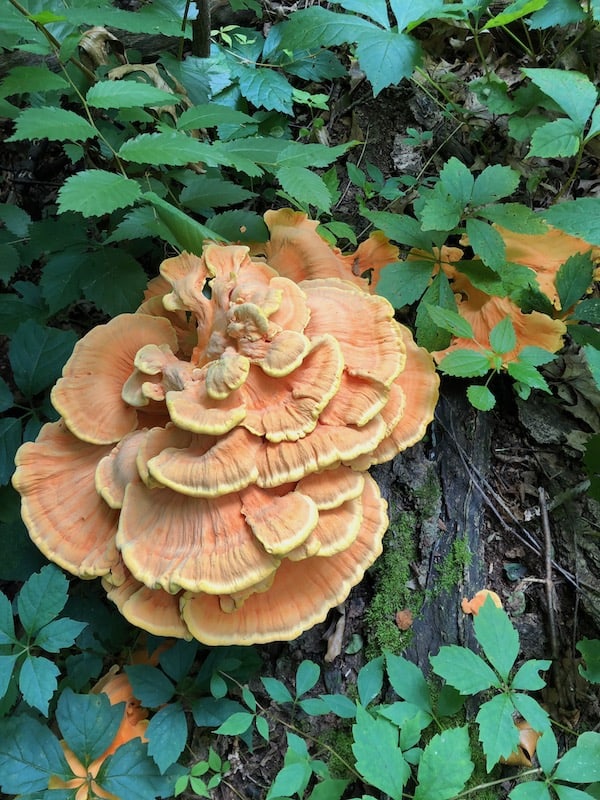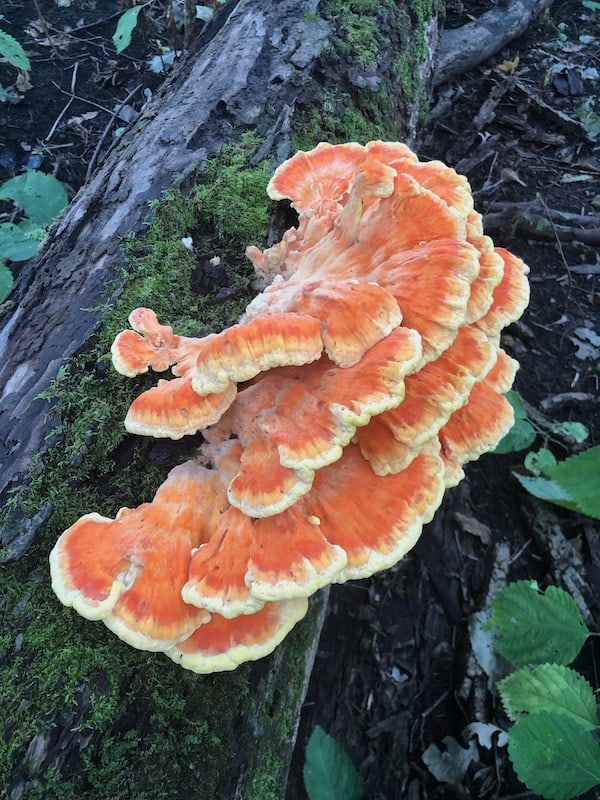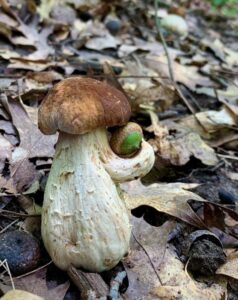KF-COW
By Mike Tangedal
I’m not as enamored with chicken fingers as today’s youth. I like chicken as much as the next omnivore, but I prefer chicken of the woods (COW). We have two varieties here, Laetiporus sulphureous and Laetiporus cincinnatus. The sulphureous variety has a bright yellow-orange top surface and a prominent yellow porous underside, whereas the cincinnatus variety has a less bright top and a white underside. Both are associated with hardwoods. Sulphureous grows mostly on the sides of trees, whereas cincinnatus is found close to the forest floor.
Much has been noted about these mushrooms for three important reasons.
- They are highly identifiable and great for mushroom beginners. Nothing transforms a burgeoning enthusiast into a raging mycologist like spotting a big stack of orange disks sticking out of the side of a tree.
- They are prized edibles. Paul Stamets lists these as some of his favorite mushrooms to eat, and I have to agree.
- They are prolific. Many a tale has been noted about foragers discovering a bloom of COW weighing more than the forager. I was recently visiting the St. Louis area, where the season started earlier than here, and came across a nice bloom from which I harvested many pounds of prized cincinnatus.
Because they grow so fast with their furious coloring, COW presents a few challenges to the forager. Any sticks, leaves, or other detritus that happens to be in the way when they emerge can and will be infused into the flesh of the mushroom. Normally, one needs to just brush the outside of the mushroom to remove dirt before eating, but with COW, the internal flesh may hold foreign material.
Secondly, they rot quickly. As noted, guru Paul Stamets has As noted, observation of the edges is important to note a bacterial infection. The sour parts will appear softer than the rest of the mushroom and/or somewhat translucent. Remove these infected bits, as this type of chicken will sour just as fast as raw chicken meat left out in the open.
Lastly, that bright color is not just a coincidence. COW broadcasts their ripeness in order to get the animal kingdom to spread their spores, and all manner of bugs and critters flock to get some food and help spread spores in the process. Before you harvest any chickens of the woods, check the underside for signs of bugs. If you see some, most likely the entire bloom is undergoing an insect feast.
But enough of the gloom. Let’s say you got a prime fresh COW. What’s the next step after cleaning off the gunk and removing any iffy bits? Well, you can’t just pop a 20-inch wide mushroom in your mouth, so you’ll need to separate it into bite size pieces, or “nuggets,” if you will.
A certain ilk of society is fond of the phrase “Tastes like chicken!” While this is painting with too broad a brush, this mushroom didn’t get its common name by coincidence. This food really is evocative of chicken. Since we all know some basic rules for cooking chicken, many of the same can be applied to COW.
First Preparation Method: Basic Sauté
After first tearing the mushroom into nuggets or cutting it into strips, the next step is a simple sauté over medium low heat in a bit of butter or the oil of your choice until browning occurs on the edges.
Then comes the essential seasoning. A certain Colonel once rose to fame by concocting 11 secret herbs and spices to flavor the most famous restaurant chicken in history. I’m not able to guess all 11, but I’d bet top-dollar that salt, pepper, and paprika were at the top of the list. I’ve prepared a LOT of chicken in my life. What really brings out the KFC experience for this mushroom is proper seasoning, especially salt. COW should be properly seasoned.
After adding salt to taste, hit them with a few grinds of pepper and a bit of paprika. Would garlic powder and onion powder also work? They sure would, as would any fun seasoning salt you may have.
Here’s another tip. The essential umami component of mushrooms jumps with the addition of an acid component. I’d suggest lime juice, lemon juice, or balsamic vinegar, but not too much; perhaps a teaspoon for every four cups of mushrooms.
This basic sauté creates the basis for a component that can be included in many other recipes, just as cooked chicken can be added to everything from salads to stir-frys. It’s a nice meaty substitute. My rating: 8 out of 10.
Second Preparation Method: Grill
Paul Stamets has a video showing his love of COW as well as his preferred method of cooking them, which is to toast them over fire on a grill. I’ve used this method many times and found it to be a bit tricky but quite tasty.
The first critical step in this process is to properly prepare your pieces of COW You will need to tear them into small enough pieces to allow them to lie flat on the grill, but not so small as to avoid the chance they’ll fall through the grate. It’s at your own discretion, but it does make a big difference.
The next step is to apply the marinade. Mr. Stamets suggests a simple mixture of teriyaki sauce and olive oil, and I can’t find fault in that. The tricky part is getting a good covering. Like all thick mushrooms, Laetiporus sp. contains a dense sponge-like structure within that contains the substance chitin. This means the COW is going to soak up the teriyaki sauce and olive oil. Go easy on the oil and don’t add so much teriyaki as to turn the mushrooms black, but don’t skimp either. Remember that COW tastes best when properly seasoned.
After the marinade comes the fire! It’s best to grill these directly over the fire on your grill. However, this will require a bit of skill. These are not made of meat, so they will cook quickly and therefore can burn easily. I suggest grilling at most eight pieces at a time and flipping them fast since each piece will be done within a few minutes. Your goal is to get a bit of char on both sides. If you are a fan of grilling, this will be your favorite mushroom to bring back to the outside. My rating: 9 out of 10.
Last Preparation Method: Fried Chicken
No one knows an omnivore who doesn’t like fried chicken, and I doubt there are any mushroom fans who won’t like fried COW The methodology for creating perfect COW nuggets is much the same as the methodology for creating fried chicken.
Use the classic Alton Brown station process by first putting all the nuggets in a pile, then next to the pile, a station for dipping in the liquid, then a station for coating with a dry mix, then a station for frying, and the final station for laying out the fried results on a rack for final seasoning. Air fryers do quite a nice job on mushrooms, and one certainly could swap out a bath of hot oil for a spritz of oil and then a few minutes in an air fryer.
Here’s what to place on your assembly line.
- The first stage is the liquid stage, and this should be buttermilk, an egg/water mix, or an approximation of buttermilk composed of four parts milk to one part apple cider vinegar.
- The next station is a bowl containing the dry ingredients. This can be either a mix of bread crumbs and flour or just flour. I like to add panko bread crumbs since they have a great texture. Add to this a healthy amount of salt and at least some paprika, pepper, garlic powder, and/or onion powder (whatever spices you like in your fried chicken). I can’t provide exact amounts since this all depends on how much COW you have.
- The last step is to give them a good pinch of salt. Once fried, they freeze well and can be used in subsequent dishes, just like plain, ordinary chicken. My rating: 10 out of 10. Breakfast of champions!
So as the weather gets warmer in Minnesota, look to the trees in your favorite foraging woods and run toward those orange shelves. Once you cook up some chicken of the woods, I’m sure you’ll agree with me that they are indeed finger-licking good!






